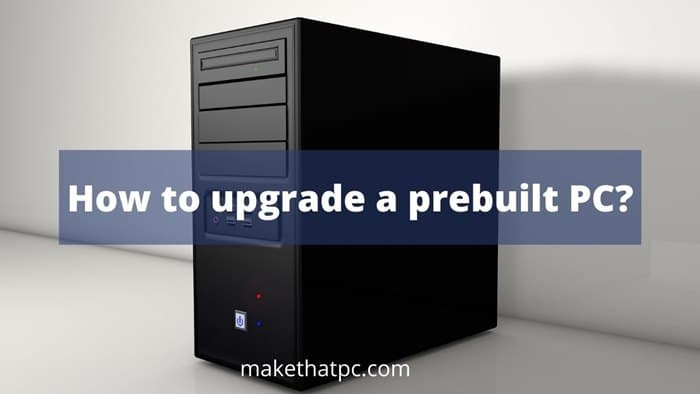Did you just get a prebuilt PC for yourself, and now you’re wondering if you can upgrade it? Or maybe you own a prebuilt PC and are thinking of upgrading it. Well, whatever the scenario is, the answer is yes! For the record, you can easily upgrade parts of your prebuilt PC.
With that said, there are certain things you need to keep in mind. Firstly, inspect your PC to see which parts can be upgraded. For instance, in some prebuilt PC cases, locking mechanisms are put in place to avoid upgrading the PC on your own. You will need to ask the manufacturer to upgrade it for you. On the brighter side, in most cases, this isn’t an issue.
Secondly, you need to check what parts you wish to upgrade and whether or not the system can handle the new features. The most issue with prebuilt PCs is the worn-out and ineffective power supply. If you are going for components that require an adequate power supply, then this is something you will have to check before you make any kind of purchase. The same goes for stuff like the GPU and RAM. Will the motherboard support the GPU and RAM sticks you are planning on investing in? It’s better to know beforehand than regret it later.
Once you have all these questions answered yourself, you will be able to begin your prebuilt PC upgrade. This is a very affordable and easy way of owning the latest PC. The fact that you’re able to upgrade it to suit your needs, without having to purchase the latest systems out there in the market is an absolute bank for your buck, isn’t it? Keep scrolling to know more!

Is it possible to upgrade a prebuilt PC?
As already discussed, it is absolutely possible to upgrade a prebuilt PC. There are two things you will have to look out for before trying to do so:
[NOTE: We’ve already mentioned this above, but we need to further break it down for you in detail]
1. The components are accessible
In some rare cases, prebuilt PCs come with a sealed shut case, which prevents anyone from dissecting it and snooping around the parts. The only way to upgrade these PCs is by sending them back to the manufacturer and they will do it for you. Remember that you should be able to access your components inside the PC in order to upgrade them.
The components are compatible
The next big thing to look for is if the components inside your prebuilt PC are compatible with the new parts you wish to purchase and use. In some cases, the major cause for concern is the motherboard. Some prebuilt PCs come with a very outdated and limited-use motherboard that makes upgrading a nightmare. Check to see what kind of motherboard your PC came with before attempting to upgrade anything.
Once you have checked both the above-mentioned points, the next thing you need to do is start sorting out which parts of the PC you wish to upgrade. This will help you understand your budget as well as give you an overall idea of what parts you need to buy and what could or could not be compatible with your system.
Things to remember before attempting a prebuilt PC upgrade
If your power source is worn-out or simply not powerful enough, you’ll run the risk of system instability and failure. Upgrades may not be possible if your computer does not have enough watts to power them (especially if you are looking for GPU upgrades). We highly recommend you replace it with an ATX, Mini ITX, or HTPC power supply.
Suppose the form factor of a power supply is not typical. Then, you’ll have a tough time making PC upgrades because of the non-standard PSU form factor. For starters, a prebuilt PC from a company like Dell, Toshiba, or Lenovo often encounters this problem. Well, the good news is that you may still determine the form factor by checking the model number of your PC to locate replacements.
Storage upgrades would be complex if your NVMe or M.2 slots are absent. Assuming that’s not the case with your PC, a PCIe M.2 adapter or a PCIe SSD may be used to enhance your storage if you already have PCIe slots.
Also, lack of memory slots or an older model of RAM makes upgrading your PC RAM difficult, However, there are still choices available to you. It is possible to upgrade the computer’s memory or discover the optimum RAM for your motherboard.
Options for upgrades would be severely restricted if there wasn’t enough room in the prebuilt PC to accommodate the needed modifications. Thin desktop workstations and outdated prebuilt PCs with unusual form factors are particularly prone to this problem.
Gaming and heavily loaded rendering or editing jobs are greatly affected by CPU bottlenecks. CPUs with strong single-core performance are required if you want to utilize a fast refresh rate display or if your PC hardware is somewhat old and slow- so keep a check on that!
What can you upgrade in a prebuilt PC?
In case you needed to know, these are the parts that you can upgrade in your prebuilt PC:
1. The CPU
CPU upgrades are a common practice for increasing a prebuilt computer’s performance. But, remember that this is a complex process as CPUs got a ton of moving elements. Try to find out whether the new CPU you’re about to purchase is compatible with your motherboard and RAM.
Once you’ve updated the CPU, you’ll need to upgrade all of the other components as well. Check to verify whether your current cooling system can handle an increase in CPU capacity. It’s also critical to pick a new CPU that’s right for your system.
On the flip side, the situation is considerably different when it comes to AMD CPUs. While upgrading, the motherboard will not be an issue as the great majority of AMD CPUs support the same chipset and socket. You may install them on any motherboard, no matter how old it is.
2. GPU
Freezing up or performance that is sluggish are the signs that suggest it is about time to upgrade your graphics processing unit (GPU). Even if the personal computer is intended for gaming, in particular, it is standard practice for vendors to install a low-end graphics card in the system. An upgrade to your computer’s graphics card is a risk-free option, provided that all of the machine’s other components are operating normally.
However, before you decide to update your graphics card, there are two things that need to be examined. Make sure that the PCIe slots on your motherboard are compatible before proceeding with anything else. Proceed to step two in order to determine whether or not the PSU is able to provide the GPU with an acceptable amount of power.
At this time, PCIe 3.0 slots are a need for all currently available graphics processing units. Certain graphics processing units can only operate at their peak level if they have access to PCIe 4.0. If your motherboard includes a PCIe slot with a speed lower than 3.0, switching to a newer GPU may not be possible in this scenario.
If you are going to use a powerful graphics card, you need to be aware that it may take as much as 750 watts of power while it is running. If the power supply unit of the prebuilt computer isn’t robust enough, you may have a number of issues after the upgrade, including a sudden shutdown. Prior to installing a new graphics processing unit, it is essential to check that your motherboard is compatible with the new GPU and that there is enough power.
Also Read: How to upgrade GPU in a prebuilt PC?
3. Storage
Consider purchasing a new storage drive if your current one is nearing its maximum capacity or is moving too slowly. If your computer often freezes or lags, you have the option of getting its software up to date. Now, the question of the hour is which is superior for gaming? A solid-state drive (SSD) or a hard disc drive (HDD)? Well, we highly recommend SSDs over conventional hard drives anyway. It is because SDDs are far better in speed, reliability, and endurance than HDDs.
So, Solid-state drives (SSDs) are faster than hard disc drives (HDDs). This means that other system components do not have to wait as long for data while SSDs are in use. In a nutshell, SSD allows the system to operate more effectively as a whole. A quick disclaimer: ensure that your prebuilt computer can accommodate the different kinds of storage you want to install before proceeding.
If you need fast storage and the prebuilt PC supports NVMe, you may choose it as the storage option. In most other situations, a SATA solid-state drive (SSD) would be the preferred choice. Since all motherboards made in the previous decade or more include SATA ports, you do not need to verify the supported storage type. You can read this SSD buying guide for more information on this topic.
4. RAM
This is the easiest part of the PC to upgrade. All you need to do is check and see if your prebuilt PC can support the desired RAM sticks you wish to use. If the motherboard does support it, then all you need to do is buy new RAM sticks and plug them in. In some cases, the RAM which you are looking to use to upgrade your PC may not be compatible with your motherboard. In these cases, you will have to upgrade your motherboard is the only way out if you need more RAM. Read this RAM buying guide to get more information on buying a new RAM.
5. The motherboard
This is the most critical component of your PC. If your prebuilt PC does not have a motherboard that supports the upgrades you wish to make, then it will be time to change everything. Buying a new motherboard isn’t expensive depending on what you are looking for. All you need to do is remove all the components from your old motherboard and plug them into your new one, and you’re good to go!
For a visual guide to upgrading a prebuilt PC, you can watch this great YouTube video.
Wrap Up
Buying a prebuilt PC is an excellent choice for people under a budget or for those who are not well versed with PC builds from scratch. The only thing to keep in mind is how accessible the components are and whether you can upgrade them when required in the future. If you have that sorted, then you can easily upgrade your prebuilt PC at any time.

I am Anshul Rana, an experienced author specializing in PC gear reviews and Windows 10 software tutorials. With a strong passion for technology and an in-depth understanding of the PC industry, I provide insightful and detailed analyses of computer peripherals, gaming gear, and software solutions. My writing style is concise yet informative, making complex topics accessible to both beginners and advanced users. Through my reviews and tutorials, I aim to offer valuable guidance, helping readers make informed decisions to enhance their PC experience and explore the vast possibilities of Windows 10 software.









